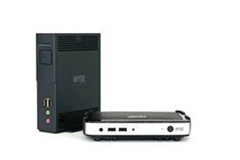Today Dell Wyse is announcing its two newest members of the P class zero client family for VMware View: the P25 and P45. Both of these products are purpose-built for VMware View and use the very latest Tera2 PCoIP processor technology from Teradici to ensure outstanding performance and graphics presentation over multiple HD displays.
The Dell Wyse P25 is an extremely compact yet powerful VMware View zero client. Less than one-third the size and boasting significant performance gains over its Dell Wyse P20 predecessor client, the P25 is built for VMware View virtual desktop users who require outstanding display performance and exceptional security. The P25 can handle demanding applications like HD multimedia and high resolution displays. Power users can also use the P25 for applications like CAD or VFX design using PCoIP remote solutions. It can present high definition video across two displays simultaneously and offers a variety of I/O and peripheral choices, including a fiber connectivity option, to enable it to easily fit into just about any work environment.
The Dell Wyse P45 takes performance up yet another notch with the ability to present high definition content across four displays simultaneously using VMware View. This device offers even greater processing and display power for those users who can’t compromise on performance. When used with PCoIP remote workstations, the P45 also handles applications like geophysical simulation and 3D solid modeling with ease. For serious users running the most demanding graphics applications over multiple HD displays, the P45 is the PCoIP zero client for them. As with the P25, the P45 offers a variety of I/O and peripheral options, including fiber connectivity.
Both these new Tera2 processor based zero clients share a number of important advancements including:
- Greater display functionality and high resolution up to 2560×1600 and 30” monitor support via DisplayPort added to existing DVI
- Higher performance, with up to five times the VDI pixel performance over the previous generation zero client
- Extremely efficient, the P25 is under 6W of typical system power and the Tera2 dual display zero clients consume half the power of the previous generation
- New quad display zero client support with VMware View
- Reduced bandwidth with client-side caching and enhanced compression
- Full power management with Wake-on-LAN support
- Smaller, more integrated processor enables compact zero client form factors, as evidenced by the extremely compact Dell Wyse P25
- Greater security via stronger AES256-bit encryption
- Additional smart card support and other new features included in the latest PCoIP Firmware and Management Console release
- Broker connectivity to virtual desktops or remote workstation hosts using VMware View Manager
“By including both the Tera2 dual display and Tera2 quad display PCoIP processors in its new P25 and P45 zero client line up, Dell Wyse provides a comprehensive set of endpoints that are high performance, ultra secure and incredibly easy to manage,” said Ziad Lammam, director, product management, Teradici. “We are excited to partner with Dell Wyse to take the PCoIP zero client experience to the next level and deliver new features and new capabilities for VMware View, remote workstation and RDSH users worldwide.”
As zero clients, the P25 and P45 are stateless end points that offer outstanding security since all software and content is safely stored and managed in the datacenter. And in addition to their impressive performance, both the P25 and P45 zero clients can be managed by Dell Wyse Device Manager (WDM) software, which means you can scale and manage your P class zero clients easily while always staying on top of what’s happening on your desktops across your enterprise.
Powerful, secure, and easy to live with, the new Dell Wyse P25 and P45 zero clients promise to make any VMware View environment even more rewarding, across campus or across the enterprise.
For more information, please read our press release and product brochure.
